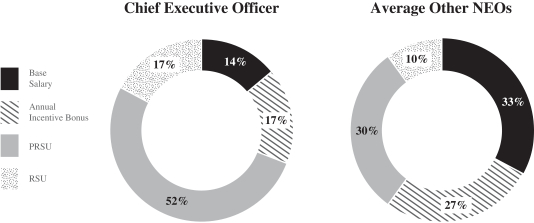global online marketplace, where he managed several key areas, including Buyer & Seller Experience. Mr. Lathi’s 20 plus years of leadership experience in the technology and
consumer space led to the conclusion that he should serve as a director of Five Below.
Richard L. Markee. Mr. Markee,
68, has served as a director since May 2016. Previously, Mr. Markee served in various leadership positions at Vitamin Shoppe, Inc., including as Non-Executive Chairman from January 2016 to June 2016 and
from April 2007 to September 2009, Executive Chairman from April 2011 to January 2016 and Chief Executive Officer and Chairman of the Board from September 2009 to April 2011. He held senior management positions at Toys “R” Us, Inc. from
1998 through November 2006, including Vice Chair of Toys “R” Us, Inc. and President of the Babies “R” Us and the Toys “R” Us U.S. and international operation divisions from August 2004 through November 2006.
Mr. Markee previously served as a director of Collective Brands, Inc., The Sports Authority, Inc., Dorel Industries and Toys “R” Us. Mr. Markee’s extensive experience in the retail industry led to the conclusion that he
should serve as a director of Five Below.
Thomas G. Vellios. Mr. Vellios, 67, is the
co-founder of Five Below and has served as our Chairman since June 2018, our Executive Chairman from February 2015 until June 2018, and as one of our directors since our incorporation in 2002. Mr. Vellios
previously served as our Chief Executive Officer from 2002 until January 31, 2015. Mr. Vellios also served as our President from 2005 until June 2014. Previously, Mr. Vellios served as President, Chief Executive Officer and a director
of Zany Brainy, Inc. Prior to joining Zany Brainy, Mr. Vellios served as Senior Vice President, General Merchandise Manager at Caldor, a regional discount chain and a division of the May Company. Mr. Vellios’ 25 plus years of
experience in the specialty, department store and discount retail industry, his experience with the management, operations and finance of a retail business, and his knowledge of the Company as a founder led to the conclusion that he should serve as
a director of Five Below.
Zuhairah S. Washington. Ms. Washington, 44, has served as a director since September 2020.
Ms. Washington is currently the President of Otrium, a purpose-driven online marketplace for designer outlet fashion brands. She has held this position since July 2021. Prior to Otrium, Ms. Washington was SVP and Global Head of Strategic
Partners, Lodging and Vacation Rentals at Expedia Group, whose brands include Expedia, Hotels.com, Orbitz and VRBO, from January 2019 to August 2021. Prior to joining Expedia, Ms. Washington was at Egon Zehnder, a global management consulting
and executive search firm, from 2018 to 2019, and Uber, where she grew businesses from startup to scale and ran one of the top five U.S. markets, from 2013 to 2018. She also founded Kahnoodle, which was named to Entrepreneur Magazine’s 100
Brilliant Companies of 2012. Ms. Washington currently serves as a director of Olo, the leading on-demand e-commerce platform for the restaurant industry.
Ms. Washington earned a joint graduate degree: a JD from Harvard Law School and an MBA from Harvard Business School, and graduated magna cum laude from UCLA with a BA in political science and public policy. In March of 2020, she was named as
one of the 100 Most Influential Black Executives in Corporate America by Savoy Magazine. Ms. Washington’s senior leadership experience with large-scale, growing technology companies led to the conclusion that she should serve as a director
of Five Below.
In addition to the information presented above regarding each director’s or nominee’s specific experiences,
qualifications, attributes and skills, we believe that all of our directors and nominees have a reputation for integrity and adherence to high ethical standards. Each of our directors and nominees has demonstrated business acumen and an ability to
exercise sound judgment, as well as a commitment of service to us and our board. Finally, we value our directors’ and nominee’s experience on other company boards and board committees.
There are no family relationships among any of our directors, nominees or executive officers.
Summary of Qualifications and Demographics of Directors and Director Nominees
The table below summarizes the specific qualifications, attributes, skills, experience and demographics of each director and nominee. In the
case of nominees, these are what led our board of directors to conclude that the nominee is qualified to serve on our board of directors. As to the knowledge, skills and experience section, while
11








